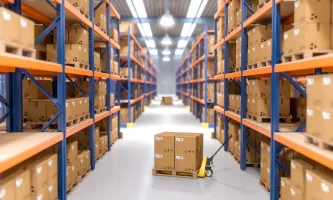Soft Credit Checks: Revolutionizing Global Business Transactions

In global business transactions, the importance of credit checks cannot be overstated. Credit checks are crucial in assessing an individual or company’s financial stability, helping businesses make well-informed decisions and minimize risks. However, with the advent of soft credit checks, there has been a significant shift in how credit checks are conducted, revolutionizing global business transactions.
Soft credit checks refer to a type of credit inquiry that does not affect an individual’s credit score. Unlike hard credit checks, which can impact credit scores and leave a lasting mark on credit reports, soft credit checks provide a less intrusive way of assessing creditworthiness. They typically involve a quick review of an individual’s credit history, focusing on key indicators such as payment history, outstanding debts, and credit utilization. By utilizing soft credit checks from https://www.softpullsolutions.com/, businesses can gain valuable insights into the financial health of potential partners, thereby allowing for more accurate risk assessments and strategic decision-making.
The distinction between soft and hard credit checks is crucial in understanding their impact on global business transactions. While hard credit checks are typically used when making significant financial decisions, such as applying for loans or mortgages, soft credit checks provide a more flexible approach, allowing businesses to assess creditworthiness without negatively impacting an individual’s credit history. This distinction is particularly important in international business transactions where trust and reliability are paramount. By relying on soft credit checks, businesses can build trustworthy relationships with partners worldwide, fostering a more efficient and secure global business environment.
Evolution Of Credit Checks
Credit checks have evolved significantly over the years, adapting to the changing needs of global business transactions. In the past, credit checks were mostly conducted through manual processes, relying heavily on physical paperwork and limited sources of information. Assessing creditworthiness is a time-consuming and subjective process. However, with the advent of technology, credit checks have become more streamlined and efficient.
The introduction of credit bureaus and online databases has revolutionized credit checks, providing businesses access to comprehensive and real-time financial information. These advancements have made assessing an individual or company’s creditworthiness easier, allowing businesses to make well-informed decisions promptly. Soft credit checks, in particular, have emerged as a game-changer in credit assessment.
Limitations Of Traditional (Hard) Credit Checks
While traditional hard credit checks have been a staple in global business transactions, they come with certain limitations. The most significant limitation is their impact on an individual’s credit score. Hard credit checks involve thoroughly examining an individual’s credit history; each inquiry leaves a mark on the credit report. Multiple hard credit checks within a short period can harm an individual’s credit score, potentially affecting their ability to secure financing or enter into business partnerships.
Another limitation of hard credit checks is that they may not provide a holistic picture of an individual or company’s financial health. They often focus on numerical credit scores without considering other factors that may contribute to creditworthiness. This narrow approach can lead to misjudgments and missed opportunities in global business transactions.
The Rise Of Soft Credit Checks
Factors Leading To The Adoption Of Soft Credit Checks
The rise of soft credit checks can be attributed to several factors, including technological advancements, growing demand for quick and non-intrusive evaluations, and evolving consumer rights and preferences.
Technological Advancements
Advancements in technology have enabled businesses to conduct credit checks more efficiently and accurately. Sophisticated algorithms and data analytics have made it possible to assess creditworthiness using various data sources, including banking transactions, social media activity, and online purchasing behavior. Soft credit checks have been a natural evolution to the next generation of credit assessment, enabling businesses to evaluate creditworthiness while minimizing intrusiveness.
Growing Need For Quick And Non-Intrusive Evaluations
As the pace of global business transactions accelerates, there is a growing need for quick and non-intrusive creditworthiness evaluations. Soft credit checks provide a more flexible approach, enabling businesses to assess creditworthiness efficiently without leaving a lasting impact on an individual’s credit history. This has heightened the appeal of soft credit checks, particularly in the lending and financial services industries.
Evolving Consumer Rights And Preferences
Consumer rights and preferences have also played a role in adopting soft credit checks. Consumers are increasingly concerned about their data privacy and are wary of companies that conduct intrusive credit checks. Soft credit checks provide a less intrusive approach, allowing businesses to protect consumer privacy while obtaining financial information.
Key Players And Innovators In The Field
Key players and innovators, including credit bureaus and fintech companies, have driven the rise of soft credit checks. These companies have developed sophisticated credit assessment models that rely on a combination of traditional credit data and alternative sources, like consumer-permissioned data, to assess creditworthiness. They have also established partnerships with businesses to offer soft credit checks as part of their credit assessment offerings, making it easier for businesses to adopt this new approach to credit assessment.
Benefits Of Soft Credit Checks
Soft credit checks offer a range of benefits that are revolutionizing global business transactions. These benefits include no impact on credit scores, speed and efficiency, improved customer experience and relations, and flexibility in global transactions.
1. No Impact On Credit Score
One of the key advantages of soft credit checks is that they do not impact an individual’s credit score. Unlike hard credit checks, which leave a lasting mark on credit reports, soft credit checks are more lenient and do not affect credit scores. This is important for individuals as it allows them to explore business opportunities without fearing damaging their creditworthiness. By preserving credit scores, soft credit checks enable individuals and businesses to maintain financial flexibility while engaging in multiple credit assessments.
2. Speed And Efficiency
Soft credit checks are quick and efficient, giving businesses timely credit evaluations. Unlike traditional credit checks that may require extensive paperwork and manual processes, soft credit checks rely on advanced technology and automated systems. This allows businesses to obtain credit assessments promptly, making it easier to make informed decisions in a fast-paced global business environment.
3. Better Customer Experience And Relations
Soft credit checks enhance the overall customer experience and improve customer relations. By utilizing non-intrusive soft credit checks, businesses respect individuals’ privacy and demonstrate a customer-centric approach. This fosters trust and strengthens relationships between businesses and their clients, crucial for successful global transactions.
4. Flexibility In Global Transactions
Soft credit checks offer flexibility in global business transactions, addressing the unique challenges of regulatory environments and global credit evaluation methodologies.
- Facilitating Business In Different Regulatory Environments
Different countries have varying regulations and practices when it comes to credit assessments. Soft credit checks can adapt to these diverse regulatory environments, allowing businesses to navigate different credit evaluation frameworks. This allows businesses to expand their global footprint and engage in international transactions more easily.
- Allowing For A More Inclusive Approach To Credit Evaluation
Soft credit checks enable a more inclusive approach to credit evaluation. Individuals or businesses with limited credit history may sometimes face challenges in traditional credit assessments. Soft credit checks offer an opportunity to consider alternative data sources, such as payment history, rental records, or utility bill payments. This broader evaluation methodology helps businesses make more accurate assessments of creditworthiness. It allows individuals and businesses with limited credit histories to participate in global business exchanges.
Applications In Global Business
Soft credit checks have found important applications in various global business sectors, including international trade and investments, global banking and finance services, e-commerce and digital transactions, risk management, and fraud detection.
International Trade And Investments
Soft credit checks play a crucial role in facilitating international trade and investments. When businesses engage in cross-border transactions, they need to assess the creditworthiness of potential partners or clients. Soft credit checks offer a convenient and efficient way to evaluate foreign entities’ financial stability and payment capabilities. This information allows businesses to make informed decisions about entering into trade agreements or investment partnerships, mitigating risks, and supporting the smooth flow of global commerce.
Global Banking And Finance Services
Soft credit checks have become integral to global banking and finance services. Banks and financial institutions use soft credit checks to assess the creditworthiness of individuals and businesses seeking loans, lines of credit, or other financial products. Soft credit checks provide a quick and accurate evaluation of creditworthiness without negatively impacting credit scores. This enables banks to make lending decisions faster, improve customer service, and reduce the risk of default.
E-commerce And Digital Transactions
In the realm of e-commerce and digital transactions, soft credit checks are essential for ensuring smooth and secure online transactions. Online marketplaces and payment platforms often rely on soft credit checks to evaluate the creditworthiness of buyers and sellers. By verifying the financial credibility of individuals or businesses, soft credit checks help prevent cases of fraud and non-payment, thus fostering trust and confidence in online transactions. This enhances the growth and development of global e-commerce by providing a secure and reliable environment for buyers and sellers.
Risk Management And Fraud Detection
Soft credit checks are crucial for global businesses’ risk management and fraud detection. Businesses can identify potential risks and detect fraud by analyzing credit data and transaction history. Soft credit checks enable businesses to make real-time risk assessments, allowing quicker decision-making and appropriate risk mitigation strategies. This is particularly important in industries such as insurance, where accurate risk evaluation and fraud detection are vital to ensure the financial health of companies operating globally.
Potential Concerns And Limitations
While soft credit checks offer numerous benefits in revolutionizing global business transactions, some potential concerns and limitations must be considered. These concerns include the accuracy and comprehensiveness of data, privacy concerns and data security, regulatory challenges in different countries, and the potential for misuse or over-reliance on soft credit checks.
Accuracy And Comprehensiveness Of Data
One of the concerns with soft credit checks is the accuracy and comprehensiveness of the data used in the assessment. Soft credit checks rely on various sources of information, such as alternative data and non-traditional credit indicators. While this can provide a more inclusive approach to credit evaluation, it also introduces the risk of incomplete or unreliable data. Inaccurate or incomplete data can lead to flawed credit assessments, potentially impacting business decisions and exposing businesses to unnecessary risks.
Privacy Concerns And Data Security
Privacy concerns and data security are significant considerations regarding soft credit checks. Collecting and analyzing personal and financial data for credit evaluations raises privacy concerns, especially in countries with strict data protection laws. Businesses must implement robust data security measures to safeguard sensitive information and comply with applicable privacy regulations. Failure to do so can erode trust and damage customer relations, potentially leading to legal and reputational consequences.
Regulatory Challenges In Different Countries
Soft credit checks can encounter regulatory challenges when operating in different countries. Each jurisdiction may have laws and regulations governing credit evaluations, data collection, and privacy. Compliance with these regulations can be complex and time-consuming, especially for businesses engaged in global transactions. Obtaining the necessary permissions and understanding the legal framework in each country is crucial to ensure the lawful and ethical use of soft credit checks.
Potential Misuse Or Over-reliance
There is a risk of misuse or over-reliance on soft credit checks in global business transactions. While soft credit checks serve as valuable tools for credit evaluations, it is important not to rely solely on them without other risk management practices. Over-reliance on soft credit checks may lead to overlooking other important factors, such as market conditions, industry trends, or qualitative assessments. Businesses should use soft credit checks as a comprehensive risk management approach, considering multiple factors in their decision-making processes.
Future Of Soft Credit Checks In Global Business
Soft credit checks are poised to play an increasingly significant role in global business transactions, driven by technological advancements, expanding reach to new markets and sectors, and potential shifts in regulations and global credit standards.
Technological Advancements And Integrations
The future of soft credit checks in global business transactions is associated with technological advancements. Emerging technologies like artificial intelligence (AI) and blockchain hold immense potential to further revolutionize credit evaluations. AI-powered algorithms can analyze vast amounts of data to provide more accurate and insightful credit assessments. With its decentralized and immutable nature, blockchain technology can enhance data security and trust in credit evaluations. Integrating these technologies into soft credit checks will lead to more efficient, reliable, and transparent assessments, facilitating smoother global business transactions.
Expanding Reach To New Markets And Sectors
Soft credit checks are expected to expand their reach to new markets and sectors. Soft credit checks have traditionally been utilized primarily in banking, finance, and e-commerce industries. However, there is increasing interest in leveraging soft credit checks in broader sectors, such as healthcare, insurance, and supply chain logistics. As businesses recognize the value of credit evaluations in mitigating risks and improving decision-making, adopting soft credit checks will likely expand across various industries globally. This expansion will provide new opportunities for businesses to make informed and secure transactions in previously untapped markets.
Potential Shifts In Regulations And Global Credit Standards
Potential shifts will influence the future of soft credit checks in global business transactions in regulations and global credit standards. As the digital economy evolves and businesses engage in cross-border transactions, there may be a need for harmonized regulations and standardized credit evaluation practices. Regulatory bodies and international organizations may play a pivotal role in establishing guidelines and frameworks for soft credit checks, ensuring fair and ethical practices while maintaining data privacy and security. A more uniform approach to credit evaluations across countries and jurisdictions can foster greater confidence and reliability in global business transactions.
Conclusion
In today’s fast-paced global business landscape, Soft Credit Checks have emerged as an indispensable tool, streamlining transactions and fostering trust across borders without compromising individual credit standings. As the world becomes more interconnected, it is paramount for businesses to stay ahead of the curve, embracing innovations that promote efficiency and inclusivity. By adopting and harnessing the benefits of Soft Credit Checks, businesses protect their interests and set the stage for unparalleled growth and expansion in an ever-evolving market.
Read Also:













